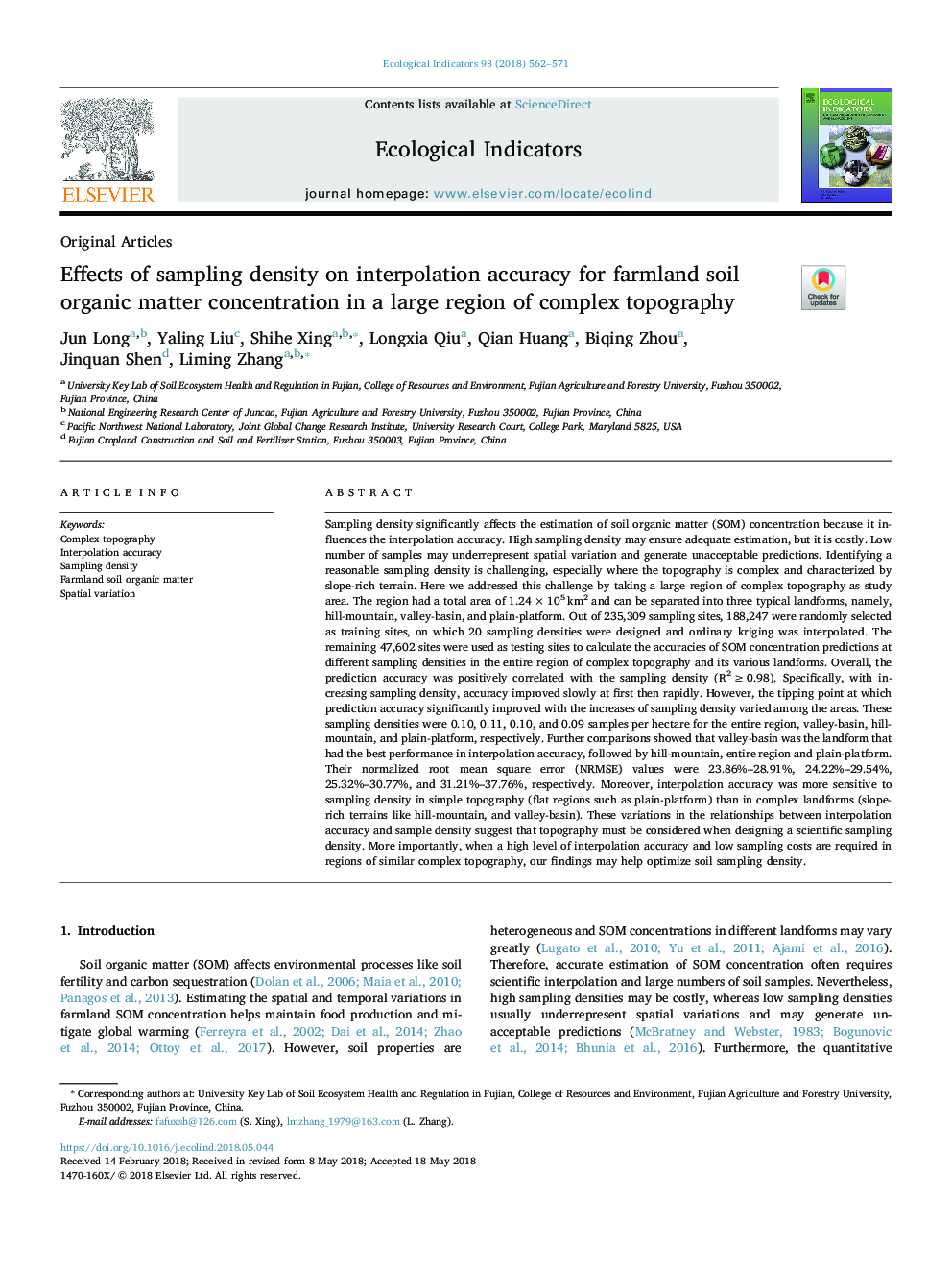| کد مقاله | کد نشریه | سال انتشار | مقاله انگلیسی | نسخه تمام متن |
|---|---|---|---|---|
| 8845179 | 1617109 | 2018 | 10 صفحه PDF | دانلود رایگان |
عنوان انگلیسی مقاله ISI
Effects of sampling density on interpolation accuracy for farmland soil organic matter concentration in a large region of complex topography
ترجمه فارسی عنوان
اثر چگالی نمونه بر روی دقت بینابینی برای غلظت ماده آلی خاک در مزرعه در یک منطقه بزرگ توپوگرافی پیچیده
دانلود مقاله + سفارش ترجمه
دانلود مقاله ISI انگلیسی
رایگان برای ایرانیان
کلمات کلیدی
توپوگرافی مجتمع، دقت بینابینی، چگالی نمونه برداری، ماده آلی زمین کشاورزی، تنوع فضایی،
موضوعات مرتبط
علوم زیستی و بیوفناوری
علوم کشاورزی و بیولوژیک
بوم شناسی، تکامل، رفتار و سامانه شناسی
چکیده انگلیسی
Sampling density significantly affects the estimation of soil organic matter (SOM) concentration because it influences the interpolation accuracy. High sampling density may ensure adequate estimation, but it is costly. Low number of samples may underrepresent spatial variation and generate unacceptable predictions. Identifying a reasonable sampling density is challenging, especially where the topography is complex and characterized by slope-rich terrain. Here we addressed this challenge by taking a large region of complex topography as study area. The region had a total area of 1.24â¯Ãâ¯105â¯km2 and can be separated into three typical landforms, namely, hill-mountain, valley-basin, and plain-platform. Out of 235,309 sampling sites, 188,247 were randomly selected as training sites, on which 20 sampling densities were designed and ordinary kriging was interpolated. The remaining 47,602 sites were used as testing sites to calculate the accuracies of SOM concentration predictions at different sampling densities in the entire region of complex topography and its various landforms. Overall, the prediction accuracy was positively correlated with the sampling density (R2â¯â¥â¯0.98). Specifically, with increasing sampling density, accuracy improved slowly at first then rapidly. However, the tipping point at which prediction accuracy significantly improved with the increases of sampling density varied among the areas. These sampling densities were 0.10, 0.11, 0.10, and 0.09 samples per hectare for the entire region, valley-basin, hill-mountain, and plain-platform, respectively. Further comparisons showed that valley-basin was the landform that had the best performance in interpolation accuracy, followed by hill-mountain, entire region and plain-platform. Their normalized root mean square error (NRMSE) values were 23.86%-28.91%, 24.22%-29.54%, 25.32%-30.77%, and 31.21%-37.76%, respectively. Moreover, interpolation accuracy was more sensitive to sampling density in simple topography (flat regions such as plain-platform) than in complex landforms (slope-rich terrains like hill-mountain, and valley-basin). These variations in the relationships between interpolation accuracy and sample density suggest that topography must be considered when designing a scientific sampling density. More importantly, when a high level of interpolation accuracy and low sampling costs are required in regions of similar complex topography, our findings may help optimize soil sampling density.
ناشر
Database: Elsevier - ScienceDirect (ساینس دایرکت)
Journal: Ecological Indicators - Volume 93, October 2018, Pages 562-571
Journal: Ecological Indicators - Volume 93, October 2018, Pages 562-571
نویسندگان
Jun Long, Yaling Liu, Shihe Xing, Longxia Qiu, Qian Huang, Biqing Zhou, Jinquan Shen, Liming Zhang,
